
Posts Tagged: rat
Rat Management in School and Community Gardens.

Managing rodents in and around school and community gardens can be difficult. One of the easiest ways to keep many rodents at bay is to remove their food source. Given that the main purpose of a garden is to grow food, it would be counter-intuitive to remove the food. However, there are many management options available to people working in gardens that are trying to protect their food from rat damage.
Habitat modification and sanitation
Making sure that the landscape surrounding your garden is well maintained may help with the management of rats. Lots of cover in the form of landscaped shrubs, trees, untrimmed palm trees etc. can provide a lot of harborage for rats to live in. These should be trimmed up and off the ground and should not be densely planted if they are in the area. Compost can provide ample harborage for rats. It is recommended to not compost food in the immediate vicinity of your garden and any other green waste should be attended to regularly to make sure that rats do not establish colonies in compost piles. Feeding of wildlife is illegal in the State of California. Therefore, the provision of food for any wildlife is illegal. The provision of food is not only illegal but it can also induce secondary pest problems like rodent outbreaks. The feeding of feral cats should also be strongly discouraged, particularly in areas where their feces could contaminate soils and other food.
Trapping
Trapping can be a very useful tool for the management of rats in gardens. If you have a rat problem in your garden it is important to be realistic about the number of snap traps that will be required to manage the issue. One or two snap traps will not curb a population. It is important to saturate an area with snap traps. Consider trapping at multiple levels also (inside beds, outside beds, on the ground, on fence lines etc.). Please be mindful of other community garden volunteers. It is important to let them know where snap traps are to reduce the risk of injury on encountering a snap trap. If you are working in a school, snap traps can be set in the evening and checked in the morning before the children get to the garden. Snap traps should not be set in gardens during the day when children are present unless they are secured in trapping stations that can be provided under contract from a pest management professional. Snap traps can also capture nontarget wildlife such as birds and reptiles. Please be mindful of these when setting traps. Nontarget mortality can be reduced by trapping only at night or by using trapping stations that can exclude nontarget wildlife. It is not advised to live-trap any wildlife in a garden. Once you trap a rat, under law, you must either release it right where you captured it, or euthanize it humanely.
Rodenticides
The use of rodenticides to manage rats in and around gardens is actually not considered legal. The majority of rodenticides available for purchase for unlicensed applicators are for structural use only. It is permitted to have rodenticide in gardens as long as you are using it to control rodents that are invading a man-made structure such as a shed, storage barn, or building. All rodenticides that are registered to manage rats must be applied in bait stations no more than 50ft away from the man-made structure, although some labels permit going further away (up to 100ft).
Placement of snap traps: (a) single trap with trigger next to wall; (b) the double set increases your success; (c) double set placed parallel to the wall with triggers to the outside.
Adapted from The Rat: Its Biology and Control, Howard, W. E., and R. E. Marsh. 1981. Oakland: Univ. Calif. Div. Agric. Sci. Leaflet 2896
Top 10 pests in gardens and landscapes and how to control them
Download the free booklet at the bottom of the page!
1. Ants

Most people deal with ants around their home at some point. Because most ants live outdoors, focus efforts on keeping ants from entering buildings by caulking entryways. Follow good sanitation practices to make your home less attractive to ants. Spraying ants inside the home will not prevent more ants from entering. Use baits to control the ant colony. Pesticide baits work by attracting worker ants who then take the poison back to the nest where the entire colony, including queens, can be killed. In the landscape, ants protect honeydew-producing pest insects from predators, so use sticky barriers or insecticide baits to keep ants out of trees and shrubs.
- Find out more at http://www.ipm.ucanr.edu/QT/antscard.html
2. Aphids

Aphids can curl leaves and produce sticky honeydew, but they rarely kill plants and you usually can wash them off with water. When aphid numbers get high, natural enemies such as lady beetles (lady bugs), lacewings, syrphid fly larvae, soldier beetles and others frequently feed on them, eliminating the need for pesticides. Protect these good bugs by avoiding the use of insecticides that can be toxic to a broad variety of insects. Ants protect aphids from these natural enemies, so keep ants away from your garden as well. When pesticides are necessary, use less toxic products such as insecticidal soaps and oils.
- Learn more about controlling aphids here: http://www.ipm.ucanr.edu/QT/aphidscard.html
3. Asian citrus psyllid and Huanglongbing disease

The Asian citrus psyllid (ACP) and the deadly bacterial disease it spreads, Huanglongbing (HLB), threaten citrus trees in backyards and on farms. There is no cure or effective control method for HLB disease. All types of citrus—including oranges, grapefruit, lemons, and mandarins—are affected as well as a few closely related ornamentals. ACP and HLB have already devastated the Florida citrus industry, and now that it is in the Western U.S. it is threatening the California citrus industry as well.
- See where the outbreaks are in California with our helpful Asian citrus psyllid website: http://ucanr.edu/sites/ACP/Distribution_of_ACP_in_California/
- Contact your agricultural commissioner's office, or call the California Department of Food and Agriculture (CDFA) Exotic Pest Hotline at 1-800-491-1899 to confirm a find. Learn more about ACP here: http://www.ipm.ucanr.edu/QT/asiancitruscard.html
4. Gophers

Gophers are small burrowing rodents that feed on roots of many types of plants. A single gopher can ruin a garden in a short time, and gopher gnawing can damage irrigation lines and sprinkler systems. In lawns, their mounds are unsightly and interfere with mowing. Early detection is critical to prevent damage. Use both traps and underground fencing to manage gopher problems. Toxic baits are available but can pose threats to wildlife, pets, and children, especially in backyard situations.
- Learn more about protecting your garden and landscape from gophers here: http://www.ipm.ucanr.edu/QT/gopherscard.html
5. Leaf-feeding caterpillars

Caterpillars, which are the larvae of butterflies and moths, damage plants by chewing on leaves, flowers, shoots, and fruit. Caterpillars in fruit or wood can be difficult to manage because they are hidden most of their life and can cause serious damage even when numbers are low. However, many plants, especially perennials, can tolerate substantial leaf damage, so a few leaf-feeding caterpillars often aren't a concern. Handpicking and beneficial predators and parasites often provide sufficient control. Look for feeding holes, excrement, webbed or rolled leaves, caterpillars, eggs, and good bugs.
- Learn more here:http://www.ipm.ucanr.edu/QT/lfcaterpillarscard.html
6. Peach leaf curl

Peach leaf curl is a fungal disease that affects only peach and nectarine trees. Distorted, reddened foliage in the spring is a distinctive symptom. New leaves and shoots thicken and pucker and later may die and fall off. An infection that continues untreated for several years can lead to a tree's decline. To prevent peach leaf curl, treat peach and nectarine trees with a copper fungicide every year after leaves fall. After symptoms appear in the spring, any treatment will not be effective. When planting new trees, consider buying peach tree varieties that are resistant to the disease.
- To learn more about preventing peach leaf curl click here: http://www.ipm.ucanr.edu/QT/peachleafcurlcard.html
7. Rats

Rats eat and contaminate food, garden produce, and fruit, and transmit diseases to humans and pets. Manage rats by removing food and shelter, eliminating entryways into buildings, and trapping. Snap traps are the safest, most effective, and most economical way to trap rats. For Norway rats, place traps close to walls, behind objects, in dark corners, and in places where you have found rat droppings. For roof rats, place traps in off-the-ground locations such as ledges, shelves, branches, fences, pipes, or overhead beams. Ensure traps are out of reach of children and pets.
- Learn more about preventing and controlling rats here: http://www.ipm.ucanr.edu/QT/ratscard.html
8. Scales

Scale insects suck plant juices and are pests of many trees and shrubs. Infestations can cause yellowing or premature dropping of leaves, sticky honeydew, and blackish sooty mold. Plant parts can distort or die back, depending on the species and abundance of scales. Most plants tolerate low to moderate numbers of scales. Provide plants with proper cultural care, especially irrigation. Encourage scale predators such as lady beetles or lacewings and look for parasite emergence holes in scale covers. Use sticky barriers or insecticide baits to selectively control scale-tending ants. Consider replacing problem-prone plants because most scales are highly specific to certain plants.
- Learn more about controlling scale populations here: http://www.ipm.ucanr.edu/QT/scalescard.html
9. Snails and slugs

These slimy mollusks emerge from hiding at night and chew holes in leaves and flowers of many succulent garden plants and fruit. Management requires a vigilant and integrated approach that includes eliminating moisture and hiding spots, trapping, setting up barriers, and handpicking. Regularly remove snails from shelters you can't eliminate such as low ledges on fences, undersides of decks, and meter boxes. Place traps in your garden and dispose of trapped snails and slugs daily. Reduce moist surfaces by switching to drip irrigation or watering in the morning rather than later in the day. Consider snail-proof plants such as impatiens, geraniums, begonias, lantana, nasturtiums, and many plants with stiff leaves and highly scented foliage such as sage, rosemary, and lavender.
- Learn more about controlling snails and slugs with and without pesticides in your garden here: http://www.ipm.ucanr.edu/QT/snailsslugscard.html
10. Weeds in landscapes

Prevent weed invasions in new beds with good site preparation. Keep weeds out with an integrated program that includes competitive plants, mulches, and hand removal. Be particularly vigilant about removing aggressive perennial weeds. You rarely should need herbicides in established landscape plantings. Mulches prevent weed seed germination by blocking sunlight. Remove small weeds by hand before they flower and set seed. Use shallow cultivation or hoeing to remove annual weeds from ornamental plantings. Only use herbicides for special-problem situations before establishing new plantings or for difficult-to-control perennial weeds.
- Learn more about controlling weeds in your landscape here: http://www.ipm.ucanr.edu/QT/landscapeweedscard.html
To see all of the University of California's Statewide Integrated Pest Management Program's information on home, garden, and landscape pests, visit http://www.ipm.ucanr.edu/PMG/menu.homegarden.html
For other short pest “Quick Tips” like the ten above, see http://www.ipm.ucanr.edu/QT/
To read even more in-depth, peer-reviewed information on many other common home and landscape pests in California, see the Pest Notes series at http://www.ipm.ucanr.edu/PMG/PESTNOTES/index.html
Download your free UC IPM Quick Tips Booklet of the Top Ten Pests in Gardens and Landscapes and How to Control Them with the link below!
Rats!
Rats! How many times have you encountered a "honey bee" on the Internet, in a book, magazine, newspaper or other publication, and found a syrphid fly misidentified as a honey bee? It's truly amazing how often syrphid flies are mistaken for honey bees. Take the Eristalis tenax, a European hover...

A drone fly, Eristalis tenax, on a Shasta daisy at the Luther Burbank Home and Gardens.. (Photo by Kathy Keatley Garvey)

A drone fly,Eristalis tenax, on yarrow at the Luther Burbank Home and Gardens. (Photo by Kathy Keatley Garvey)

Close-up of a drone fly, Eristalis tenax. (Photo by Kathy Keatley Garvey)
Accidental dog poisoning on the rise

Veterinarians at the University of California, Davis, warn pet owners to be careful about using rat poisons and similar compounds.
In recent weeks, veterinarians at the UC Davis William R. Pritchard Veterinary Medical Teaching Hospital have seen a spike in accidental rodenticide poisonings. In the last two weeks of August alone, they diagnosed and treated six canine cases.
If not treated, a dog can die within a week of ingesting rodenticides.
"This is an all-too-common occurrence," said Karl Jandrey, assistant professor of clinical small animal emergency and intensive care at UC Davis. "People are trying to get rid of unwanted rodents, but are not realizing what these toxins do to the other animals who share that environment."
Keeping pets safe
Using proper pest control techniques can help keep family pets safe, said Roger Baldwin, UC Cooperative Extension advisor with the UC Integrated Pest Management Program. Baldwin, a wildlife pest management expert, is based at the UC Kearney Agricultural Research and Extension Center in Parlier.
Dogs can be affected by rodenticides two ways: by eating the poisoned bait or by eating an animal that was poisoned. Both can have serious consequences.
Home improvement stores like Lowes and Home Depot, and even grocery stores, carry a variety of products that may be used to control unwanted rats, mice, pocket gophers and ground squirrels. If the unwanted animals are inside the house, Baldwin recommends using traps rather than poison.
"If a poisoned animal dies behind a wall, you can't get it out and you have to live with the smell for weeks or months," Baldwin said.
Also, before baiting outdoor pests, Baldwin suggests making sure they are not also going inside buildings. If they are, find all potential access points and close them up.
If resorting to poison baits, buy a new product at the store and carefully read the label to understand when, where and how it can be used. Because of rapidly changing restrictions in recent years, old products in your garage or shed could be outdated.
Pocket gopher bait must be placed in the gopher's underground burrow. Even there, Baldwin said, certain dogs will dig up dead pocket gophers if they are close enough to the surface. Families with digging dogs will likely want to choose gopher traps. For ground squirrels, baits can be placed in bait stations or scattered very thinly on the ground through broadcast or spot treatments.
"When you use broadcast or spot treatments, there is relatively little danger to dogs or cats," Baldwin said. "But I would opt to use bait stations in my yard if I had pets running around, just to be on the safe side."
Some rodenticides contain ingredients that are anticoagulants, which slow the clotting of the blood. When dogs ingest these poisons, the active ingredients concentrate in the liver where they interfere with vitamin K storage and the production of blood clotting factors.
At UC Davis' veterinary teaching hospital, dealing with accidental poisoning by an anticoagulant rodenticide can require around-the-clock care with treatments in the intensive care unit to replenish blood clotting factors with fresh frozen plasma and replace vitamin K. If administered early enough, this treatment usually leads to a full recovery. Other rodenticides (e.g., bromethalin, cholecalciferol, strychnine and zinc phosphide) do not have antidotes, so treatment is more difficult.
One patient recently treated at UC Davis was Mocha, a one-year-old Belgian Malinois from Winters, Calif. Mocha had gotten into d-CON, a common rodenticide available at hardware stores.
Luckily, Mocha was brought to the veterinary teaching hospital in time. She responded well to treatment and was able to go home in two days.
"We are grateful for the care Mocha received at UC Davis," said Ken Shaw, Mocha's owner. "Like most dogs, Mocha is adventurous and likes to get into things she shouldn't. But after the treatment at UC Davis, she was home within a few days, happy and playful once again."
Flies Are Pollinators, Too!
You may have noticed this little floral visitor in your garden. It might appear to be a bee, a common mistake to the untrained eye or those who think that all floral visitors are bees. But it's a fly, and flies are pollinators, too! This fly, from the genus Eristalis, family Syrphidae...

Close-up of a fly, genus Eristalis, on a flower. (Photo by Kathy Keatley Garvey)

Flies are pollinators, too! This little Eristalis is nectaring a zinnia. (Photo by Kathy Keatley Garvey)

Side view of an Eristalis. (Photo by Kathy Keatley Garvey)

